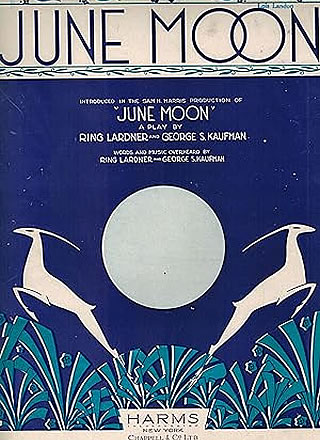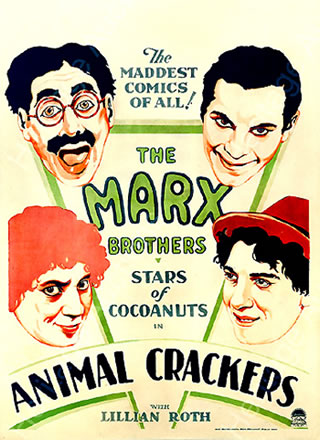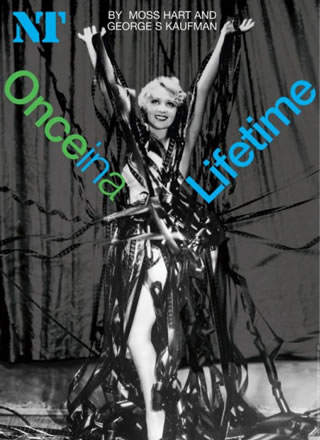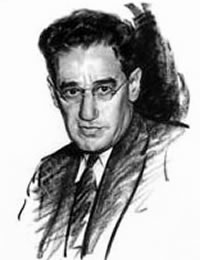June Moon
(1929)
By Ring Lardner and George S. Kaufman

Cast size: 7 men, 5 women (One man can be cut); 3 sets
June Moon is, sadly, Kaufman’s only play with his fellow Round Table member and humorist Ring Lardner. Kaufman admired Lardner’s 1921 Saturday Evening Post short story called “Some Like It Cold,” in which Fred Stevens’ adventures as a Tin Pan Alley lyricist are recalled in a series of letters to his girlfriend, Edna.
For performance rights, contact: Concord Theatricals

Table of Contents
The Plot

His composing partner, Paul Sears, is having problems with his own marriage and his sister-in-law, Eileen, turns her digging sights on Fred after he and Paul have a minor hit with a song, “June Moon.” Sudden fame and fortune go to Fred’s relatively empty head, until he realizes that he and Edna are meant for each other—like “June” and “moon.” Serving as 24-bar Greek chorus is Fred’s friend and mentor, Maxie, Tin Pan Alley’s resident song-plugging genius and cupid, who remarks about the song “June Moon”:
“It’s a tune that’s easy to remember, but if you should forget it, it wouldn’t make any difference.”
About the play
 June Moon is, sadly, Kaufman’s only play with his fellow Round Table member and humorist Ring Lardner. Kaufman admired Lardner’s 1921 Saturday Evening Post short story called “Some Like It Cold,” in which Fred Stevens’ adventures as a Tin Pan Alley lyricist are recalled in a series of letters to his girlfriend, Edna. Lardner, one of America’s most successful humorists and journalists, was initially reluctant to participate in adapting another of his works for a Broadway show, having had several previous unpleasant experiences. But, perhaps seduced by the opportunity to write the music and lyrics for a few clever Tin Pan Alley pastiches, he succumbed.
June Moon is, sadly, Kaufman’s only play with his fellow Round Table member and humorist Ring Lardner. Kaufman admired Lardner’s 1921 Saturday Evening Post short story called “Some Like It Cold,” in which Fred Stevens’ adventures as a Tin Pan Alley lyricist are recalled in a series of letters to his girlfriend, Edna. Lardner, one of America’s most successful humorists and journalists, was initially reluctant to participate in adapting another of his works for a Broadway show, having had several previous unpleasant experiences. But, perhaps seduced by the opportunity to write the music and lyrics for a few clever Tin Pan Alley pastiches, he succumbed.
The out-of-town tryout in Atlantic City was bumpy and the script was incomplete; “I’m down here with an act,” remarked Lardner upon encountering a friend on the boardwalk. But, by its Broadway opening, Kaufman and Lardner had created a unique blend of their respective skills: Kaufman’s craftsmanship and gift for characterization combined with Lardner’s surreal wordplay and cynical world view.
No other play—or musical—of the period takes such accurate aim at the banal bromides pitched at the American public by the worst kinds of popular song. Indeed, June Moon implies that anyone can write a hit song—provided they employ the lowest common denominator. Typical is one moment at Goebel’s Music Publishing firm, when, in the middle of a song demonstration, one character after another bolts into the next studio to catch a glimpse of the godlike George Gershwin. “He stole my rhapsody!” shouts one envious hack composer.
Stage history
June Moon was the last major comedy to open on Broadway before the Stock Market Crash. It had its premiere on October 9, 1929 at the Broadhurst and ran 249 performances. A filleted screen version starring Jack Oakie appeared in 1931, and the material largely vanished from the public eye until Burt Shevelove adapted it for PBS in 1974. With an impressive cast, consisting of Jack Cassidy, Susan Sarandon, Estelle Parsons, and Stephen Sondheim, making his television dramatic debut as Maxie, the program received much critical acclaim. The Drama Department, an Off-Off-Broadway company, revived it in 1996 in a well-regarded production that moved to an Off-Broadway theater for a brief run.
Other Plays in the Catalogue
Silk Stockings' producers, Cy Feuer and Ernest Martin, had a success with Guys and Dolls in 1950. Attempting to work again with Kaufman, who directed that production, they ultimately balked at the romantic aspect of Kaufman's adaptation of the film, which he wrote with his second wife, Leueen MacGrath.
Throughout his career, Kaufman made a fine art out of the revue sketch, the most popular theatrical form on Broadway in the 1920s and early 1930s. Several of his sketches are absolute classics and they can be singly or as part of a larger evening.
In the heady days of the New Deal, the government was dispensing a check to thousands of worthy organizations around the country. Two unscrupulous bankers decide to bilk Washington, DC by starting a phony railroad, farm, and bank securities system—all based out of their New York apartment.
Table of Contents
Contact Us Today
Interested in bringing George S. Kaufman’s timeless plays to your stage?
Please refer to the contact information for each specific play on the various collection pages for direct amateur and professional licensing information.
Plays are represented by Concord Theatricals, Broadway Dramatic Licensing, and Music Theatre International respectively
If you are interested in first-class performance or film/television rights:
In the US, George S. Kaufman’s plays are represented by:
CPK Artists, LLC
In the UK, George S. Kaufman’s plays are represented by:
Alan Brodie Representation
For more information about George S. Kaufman or this website, contact:
Laurence Maslon
Literary Trustee, George S. Kaufman Estate







